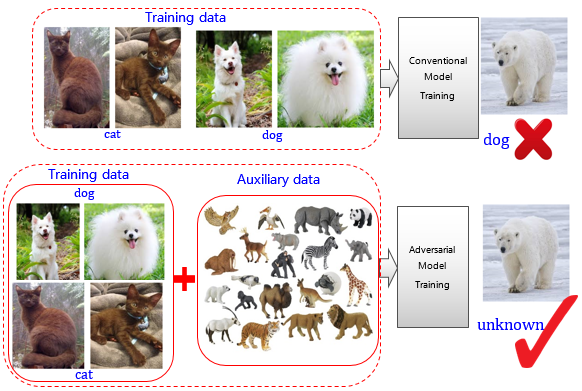Archived content
NOTE: this is an archived page and the content is likely to be out of date.
Fujitsu Develops Deep Learning Technology based on Adversarial Training and Auxiliary Data
Recognizing instances of unknown classes
Fujitsu Research & Development Center Co. Ltd.
Beijing,China, February 05, 2018
Fujitsu R&D Center Co., Ltd. today announced an advanced deep learning technique for object recognition. By applying the developed technique, objects from unknown classes can be recognized with high accuracy. The technique utilizes two types of training data to train the same recognition engine. One type of training data comes from known classes to learn features for known classes. The other type of data is auxiliary data. It’s trained by adversarial training method to enhance the feature representation for unknown classes. Comparing with conventional supervised learning techniques, it can achieve high accuracy for unknown class data. In a recent research for ancient Chinese character recognition, the technique successfully reduce the relative error rate by 20%. We hope this technique can be used to extent the application of deep learning and make contribution to the general artificial intelligence platform in the future.
Details are being announced at the “IS&T International Electronic Imaging Symposium 2018” held on January 28, Tuesday in San Francisco, USA.
【 Background 】
Deep learning technology has been widely used for AI related tasks with promising performance. However, it is essentially based on the close set assumption that the testing data pertains to one of classes that are used during training. But in practice, during testing time, data may come from a class that is not necessarily seen in training. Many applications have to face the problem that new concepts will form during system operation, new categories will arise, and the system needs to have the ability to detect these unknown new classes. To solve this problem, it takes much time and effort to obtain the samples of these unknown classes during training, which is sometimes impossible for certain task. All of these reasons have hindered the expansion of DNN application fields.
【 Topics 】
In order to let the deep learning based algorithm to detect unknown classes, we developed a deep learning model based on adversarial training. Deep learning method is a data-driven. Training data plays an important role in the detection of unknown classes. As shown in Figure 1, the training data comprised only of images of white dogs and of brown cats, as shown at the first row. A conventional model based on close set training incorrectly labels a white bear (test image) as a dog with high confidence. For the white bear, it is an unknown class to the training dataset. It is difficult to obtain the effective feature which can differentiate the input test image as an unknown class. Auxiliary data contains external information similar to test instance. If we train a model leveraging the external auxiliary dataset, as shown in the second row, the model can learn a good feature which can differentiate the bear from cat and dog classes.
 Figure 1: Deep learning model based on adversarial training can detect unknown classes
Figure 1: Deep learning model based on adversarial training can detect unknown classes
【 Technology 】
1.Feature learning from known classes data for representation and classification
A classifier based on convolutional neural network is trained by known class data to obtain high-precision recognition rate as well as the feature representation of known class data. In order to improve the capability of deep learning algorithm to detect unknown classes, we use two strategies to train convolutional neural networks. One strategy ensures the accuracy of classification and the other strategy enhances the similarity between the known class features so as to improve the unknown class detection.
2.Feature enhancement by auxiliary data for unknown detection
To improve the unknown detection capability, we utilize auxiliary data to enhance the features representation. Our algorithm utilizes unlabeled auxiliary data, which has wide adaptation. The algorithm uses Generative Adversarial Network for feature enhancement learning. We use the aforementioned known class data and auxiliary data to jointly optimize the network to get strong features for unknown detection. Finally, we extract features from the trained network model for unknown class detection.
 Figure 2: The framework of adversarial training for unknown detection
Figure 2: The framework of adversarial training for unknown detection
【 Effect 】
The developed technique was applied to Dunhung character dataset [1] for unknown character detection. The detection rate improves from 52% to 63% when the false positive rate is set to 10%, and from 73% to 82% when the false positive rate is 20%. False positive rate refers to the ratio of number of known samples, which are misclassified as unknown samples, to the total number of known samples.
 Figure 3: Results on Dunhuang historical Chinese dataset
Figure 3: Results on Dunhuang historical Chinese dataset
【 Future】
We plan to apply this technology into various image recognition tasks and install to Fujitsu’s AI platform Zinrai in 2018 fiscal year.
【 Notes 】
About Fujitsu
Fujitsu is the leading Japanese information and communication technology (ICT) company offering a full range of technology products, solutions and services. Approximately 155,000 Fujitsu people support customers in more than 100 countries. We use our experience and the power of ICT to shape the future of society with our customers. Fujitsu Limited (TSE: 6702) reported consolidated revenues of 4.5 trillion yen (US$40 billion) for the fiscal year ended March 31, 2017. For more information, please seehttp://www.fujitsu.com.
About Fujitsu R&D Center Co., Ltd.
Established in 1998, Fujitsu R&D Center Co., Ltd. is a wholly owned R&D center of Fujitsu Limited, located in Beijing. The center's research areas cover the major business fields of the Fujitsu Group, including information processing, telecommunications, semiconductors, and software and services. For more information, please see: http://www.fujitsu.com/cn/frdc/en/
All company or product names mentioned herein are trademarks or registered trademarks of their respective owners. Information provided in this press release is accurate at time of publication and is subject to change without advance notice.
Press Release ID: 2018-02-05
Date: 05 February, 2018
City: Beijing,China
Company:
Fujitsu R&D Center Co., Ltd.
![]() E-mail: yuxiaoyi@cn.fujitsu.com
E-mail: yuxiaoyi@cn.fujitsu.com


